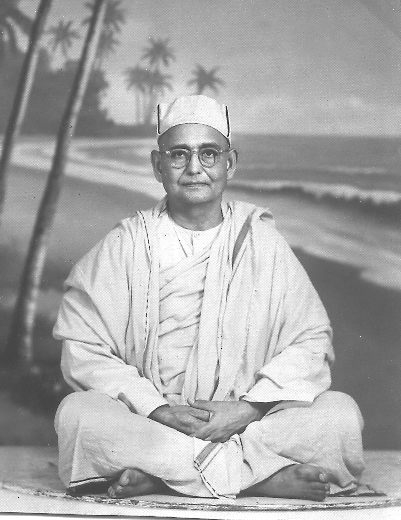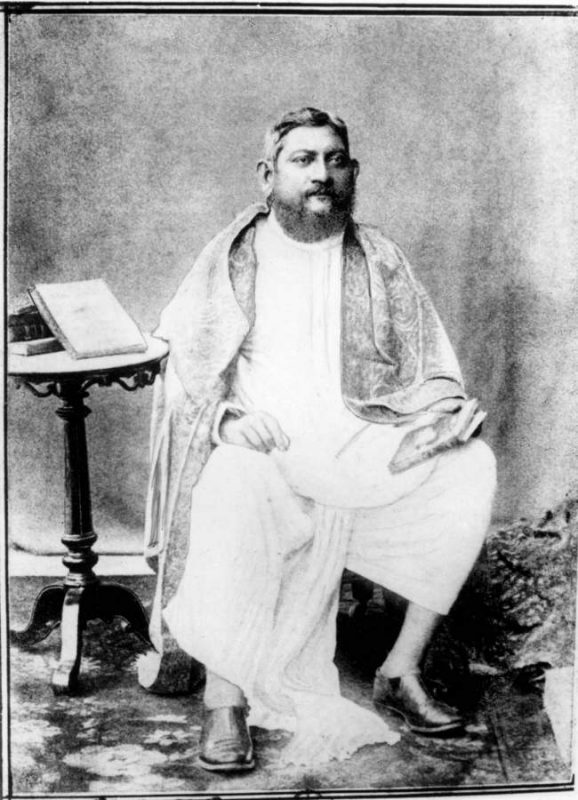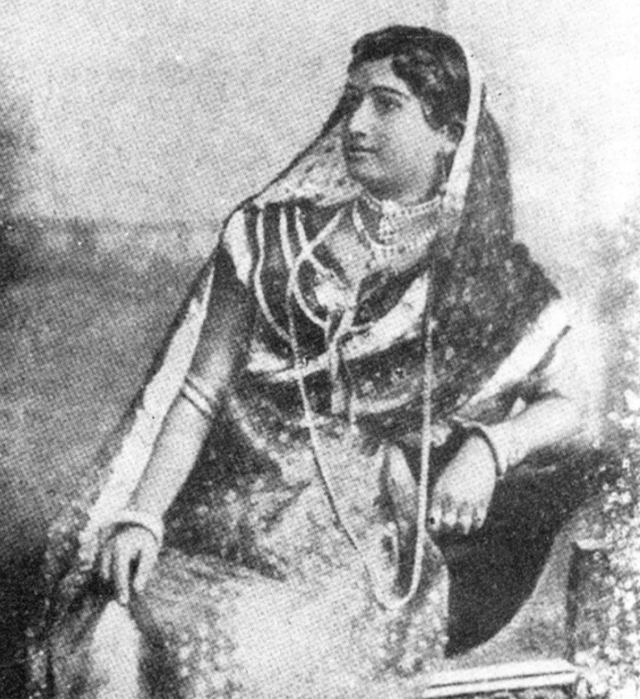by Sibatosh Bagchi
When describing himself, Sri Ramakrishna used two relevant examples — the Karmanasha River and the erstwhile French colony of Farashdanga in Bengal respectively.1 The Karmanasha, which literally means ‘destroyer of karma’ is a tributary of the Ganga crossing through the Indian states of Uttar Pradesh and Bihar. Just as one bathes in the Ganga to wash away one’s sins, so Sri Ramakrishna compared himself to the Karmanasha, which would put an end to all karmas when one takes a dip into it.
Chandernagore — now known as Chandannagar — is a part of the Hooghly district of West Bengal that was once under the French rule. In Bengali it was called Farashdanga, French colony. Any individual committing a crime in the then Bengal Presidency, which was under British rule, could slip into this French colony to escape arrest and subsequent punishment. Sri Ramakrishna said he is such a refuge.
Avatara : A source of unending spiritual power and knowledge
Sri Ramakrishna gave a very lucid example regarding the spiritual strength of an Avatara, or of great rishis like Narada:
“A hollow piece of driftwood somehow manages to float; but it sinks if even a bird sits on it. But Narada and sages of his kind are like a huge log that not only can float across to the other shore but can carry many animals and other creatures as well. A steamship itself crosses the ocean and also carries people across.”2

An Avatara has to take care of the spiritual demands of millions of people as his primary function is the redemption of humanity. He says very appropriately that an Avatara is like a hole through which one can see the other side, which is inaccessible otherwise to one’s view.
In a different context Swami Ramakrishnananda, a direct disciple of Sri Ramakrishna, once said:
“The Master was able to supply to every man just what he needed. Sometimes a man would come from a distant place with his heart panting for God, but seeing the room full of people, he would shrink back and hide himself in a dim corner. Without a word, Sri Ramakrishna would walk to him and touch him, and in a moment he was illumined.
“By that touch, Sri Ramakrishna really swallowed ninety-nine percent of the man’s karma. Taking others’ karma was the reason he had his last long illness. He used to tell us: ‘The people whose karma I have taken think that they are attaining salvation through their own strength. They do not understand that it is because I have taken their karma on me.’”3
There are many other, similar instances that demonstrate Sri Ramakrishna’s spiritual power and knowledge. Swami Shivananda, another direct disciple, mentioned many times the Master’s innate capacity to lessen any individual’s accumulated instincts of previous births, in a moment. By his own will he could change the direction of that person’s whole mind towards the supreme goal of God-realization. He would straighten permanently all the twists of a man’s mind; that man would be transformed into a saint. Girish Ghosh was a shining example of the power of an Avatara.4
Regarding the Avatara’s infinite knowledge, Swami Vivekananda narrated a series of incidents that prove Sri Ramakrishna as an embodiment of measureless knowledge. Swamiji said:
“When I began lecturing in Chicago and other cities, I had to deliver every week some twelve or fifteen lectures at times. This excessive strain on the body and mind would exhaust me to a degree. I seemed to run short of subjects for lectures and was anxious where to find new topics for the morrow’s lectures. New thoughts seemed altogether scarce. One day, after the lecture, I lay thinking of what means to adopt next. The thought induced a sort of slumber, and in that state I heard as if somebody standing by me was lecturing—many new ideas and new veins of thought, which I had scarcely heard or thought of in my life. On awaking I remembered them and reproduced them in my lecture. I cannot enumerate how often this phenomenon took place. Many, many days did I hear such lectures while lying in bed. Sometimes the lectures would be delivered in such a loud voice that the inmates of adjacent rooms would hear the sound and ask me the next day, ‘With whom, Swamiji, were you talking so loudly last night?’ I used to avoid the question somehow. Ah, it was a wonderful phenomenon.”5
Sri Ramakrishna continued to help his sincere devotees at the time of their crises. Swami Abhedananda told of an experience in which he was saved by Sri Ramakrishna in a critical situation. In 1915, he was about to leave London and visit America. He went to the ticket counter on 6th May to book his ticket on the S.S. Lusitania. As soon as reached the counter, some mysterious voice cautioned him not to buy it. He was perplexed and came back home deciding to visit again the next day. On 7th May, again a supernatural voice cautioned him.
The next morning when he opened a newspaper, he read “S.S. Lusitania is no more” in bold letters. He was overwhelmed with emotions and tears rolled down on his cheeks. He could easily believe that Sri Ramakrishna had warned him twice not to buy a ticket. Nearly 1200 people died when that ship was sunk by a German submarine, near the coast of Cork in Ireland.6

Swami Yatishwarananda, a venerable monk of the Ramakrishna Order tells us:
“In 1933 I was sent to Wiesbaden (Germany) for some specific work. On the journey I was the only passenger in the second-class berth of the ship—feeling quite nervous. Suddenly I felt some divine presence around me that was about to engulf me from all sides. The presence was quite palpable by my body and mind—in the midst of this ambience was Sri Ramakrishna’s voice. He was pointing his finger towards himself and said: ‘Don’t be nervous. This time (in this incarnation), infinite power is being manifested through this body. This (I) will protect you.’ After this incident I could feel his divine presence always within me.’”7
Sri Ramakrishna’s infinite spiritual dimensions were revealed to various devotees in different forms. It all depended on their capacity to comprehend him. If we recall some of these incidents, we find that he would fulfill the wishes of devotee and manifest himself as the devotee’s Ishta Devata, Chosen Ideal. This satisfied his or her spiritual urge and brought peace to the minds of many devotees.
Sri Ramakrishna revealed himself as Shiva and Kali to Mathur Babu, who totally surrendered himself at the Master’s lotus feet after this vision. Kaliprasad (later Swami Abhedananda) had a vision of all the incarnations and acharyas merging into the body of Sri Ramakrishna. Aghormani Devi, Gopaler Ma, used to see him as Gopala, the child Sri Krishna. He came as Sri Gauranga to his guru Yogeshwari, Bhairavi Brahmani. Swami Turiyananda saw Sri Ramakrishna inside the Jagannatha Temple at Puri. The devotee Nistarini Ghosh found her Ishta Devata, Sri Krishna, in Sri Ramakrishna, when he went into deep samadhi in her house at Badurbagan in North Calcutta. Many more examples are found in the lives of devotees and disciples.8
His role as the supreme life changer
During his short life of fifty years, Sri Ramakrishna gave solace and spiritual support to hundreds of people. After his demise he continues to play the same role for millions. Swami Vivekananda used the epithets pranarpana (one who gives his life for others), and jagata-tarana Ione who protects the world), to describe Sri Ramakrishna in his famous aratrika bhajan. This is because the Master sacrificed himself only for the welfare of humanity, and came to protect all who would take refuge unconditionally at his lotus feet.
Generally in his biographies we observe the Master to be busy whole day singing, dancing, and talking to all who visited him. But behind these activities, there was his great concern for the welfare of others and eagerness to help those who were suffering from different kinds of afflictions, mainly spiritual. From morning till midnight, Sri Ramakrishna spent his time advising, guiding, inspiring and awakening those who visited him, many from far-away places. And everyone who met him with spiritual hunger returned from him having received something life-transforming. In this painstaking process, Sri Ramakrishna had to undergo vicarious suffering.
Innumerable people visited him at Dakshineswar and other places during his active life of nearly thirty years; some of them met him only once or twice but that was enough to change the lives dramatically. In the following lines, we would like to point out to eight individuals from the many.

Girishchandra Ghosh (1844-1912) is the most striking example of Sri Ramakrishna’s divine grace. Girish’s gradual transformation of mind was due to his total and unconditional surrender to Sri Ramakrishna. Poet, actor, playwright, and one of the progressive founders of modern Bengali theatre, Girish had firm faith from the beginning in the Avatarhood of Sri Ramakrishna and, at his behest, gave the Master “power of attorney” over all Girish’s worldly and spiritual life.
Though he had unflinching loyalty to his guru, once Girish was brooding with a broken heart over his own misdeeds when the Master, in a semi-conscious mood, said, “Girish Ghosh, don’t worry about it; people will be astonished at the marvelous change that will come over you.”‘9
In every Avatara’s lila (significant but inscrutable work of an Incarnation), there is always a character who attains a marked mental elevation through the infinite love and compassion of the guru and, in turn, this character becomes an example to millions of other people. In the Sri Ramakrishna incarnation it was Girish who played this crucial role. It was he who triggered the Kalpataru phenomenon on 1 January 1886, when Sri Ramakrishna blessed all the assembled devotees with his profound words: “What else should I tell you! I bless you all. Be spiritually awakened!”10
Girish attained a high spiritual state of mind towards the end of his life.

A less known character in the Ramakrishna lila was Binodini Dasi (1863-1942), a famed stage-actress of Calcutta in those days. At a young age, she started her career as a successful courtesan and became famous in the ‘Babu’ (dandy) circle of Calcutta.
From 1875 she started acting under the care and guidance of her mentor, Girishchandra Ghosh. Known as Notee (actress) Binodini, during just twelve years she became famous as a successful actress, playing nearly eighty roles including those of Sita, Draupadi, Radha, Kaikeyi, and Pramila, among others.
On 21 Sept 1884, Sri Ramakrishna saw her epoch-making performance as Sri Chaitanya in Girishchandra’s play ‘Chaitanyalila’. The Master commented in an ecstatic mood, “I found the representation the same as the real.”11
At the end of the play, Girishchandra escorted Binodini to Sri Ramakrishna for his blessings. The Master placed his hand on Binodini’s head saying, “Mother, may you realize God!”12
In other plays by Girish — Prahlad-charitra, Brishaketu, Dasha Mahavidya and Nimai-sannyas, the Master watched her performances as Prahlad, Padmavati, Sati and Nimai respectively.
Binodini’s premature retirement from the stage in 1886, at the age of 23 is not sufficiently explained, though some people reasonably consider it to be due to Sri Ramakrishna’s spiritual influence on her.
There is an amusing incident concerning Binodini. Disguised as a boy — a Western devotee — she succeeded in getting through the door at Shyampukur, where visits to the critically ill Sri Ramakrishna were restricted. Binodini fell at his feet and wept looking at him. Quite surprised by her presence, Sri Ramakrishna blessed her this time also.
In her later years, Binodini also met Swami Abhedananda at Sri Ramakrishna Vedanta Math, Calcutta. Notee Binodini was a wonderful character whose life was transformed by Sri Ramakrishna, who blessed her that she might realize God.
A third individual whose life may be remembered with reverence is Bhavatarini Mukhopadhay (1877-1973). She was the wife of Upendranath Mukhopadhya, a lay disciple of the Master. Her name Bhavatarini was given by Sri Ramakrishna himself. She was also known as “Basumati Ma”. She also was closely related to Sri Sarada Devi. It is known from her autobiography13 that she came in close contact with the Master and Sri Sarada Devi during her childhood and adolescence.
Her marriage to Upendranath was proposed by Sri Ramakrishna himself. However, in 1919, at a very young age she lost her husband, and also her only son a few years later. These tragic incidents compelled her to move to Varanasi where she lived for the rest of her life. With Sri Ramakrishna at the centre of her heart, she lived a very austere and intense spiritual life up to the age of ninety-six years. Remaining in very exalted states during those days, she used to have innumerable visions of Sri Ramakrishna and Sri Sarada Devi.14
Vijay Krishna Goswami (1841-1899), a leader of the Brahmo movement in Bengal, frequented Sri Ramakrishna at Dakshineswar in search of God; the conventional Brahmo ideas of that time could not satisfy him.
He had deep respect for Sri Ramakrishna, as could be seen from this comment: “It is difficult to understand him (meaning the Master) unless he reveals himself. Here alone is the one hundred percent manifestation of God….I have now realized who you are. You don’t have to tell me.”
In a state of ecstasy, Sri Ramakrishna said,”If so, then so be it!”15 A transformed Vijaykrishna fell at the Master’s feet and held them on his chest, clinging to them. Sri Ramakrishna was very happy with Vijay’s comprehensive knowledge about him and in the process revealed himself to Vijay.
Due to the Master’s miraculous, super human influence, Vijay gave up all his association with the Brahmo movement around 1886-87 and started his further inner journey towards the ultimate reality.
The story of Manmatha Bhattacharya, at first a well-known gymnast and wrestler of the Baghbazar area of Calcutta, is equally charming. Sri Ramakrishna’s grace fell on him in a most unusual way. Manmatha was hired by Hiralal, Yogin-Ma’s brother, to frighten away Sri Ramakrishna when he came to Yogin-Ma’s house. Hiralal did not like his sister’s frequent visits to the Master at Dakshineswar.
Manmatha was at the house when Sri Ramakrishna arrived and heard a few words of the Master. He was so captivated by those words that he fell at the Master’s feet and asked the Master to forgive him for his nefarious intention. Sri Ramakrishna invited him to visit Dakshineswar one day.
On the first visit he accompanied Manmatha to the Kali temple and there blessed him. The next time also Manmatha received some advice from the Master. But he never disclosed anything about the grace he received. Within a couple of years, Manmatha had a miraculous transformation to become a totally different man.
He always used to utter with folded hands, ‘Priyanath, Priyanath’ ( O my beloved Lord). Manmatha came to the Baranagore Monastery in 1890 when Swami Vivekananda and other swamis were there. His great transformation by the divine touch of Sri Ramakrishna surprised all of them.16
Nistarini Devi (?-1932) was the wife of Sri Ramakrishna’s lay disciple Navagopal Ghosh; the Master considered her to be an incarnation of “Chhinnamasta” (an aspect of Durga). She had a profound change in her spiritual life after meeting Sri Ramakrishna along with her husband. Her entranced mood lasted for six months after her first visit. She had the rare opportunity of feeding Sri Ramakrishna with her own hands. One day Sri Ramakrishna visited their residence in Calcutta and went to the first floor to bestow grace on Nistarini.
In their shrine room, there was a photo of Sri Krishna and Nistarini confided to him that she wanted to have ‘darshan’ of Sri Krishna. The Master went into deep samadhi and appeared exactly as Sri Krishna. (6) Nistarini attained spiritual realization through ‘japam’ and survived up to 1932. Transformed by Sri Ramakrishna’s grace, her later life was blessed with many spiritual visions. Once she had vision of her Ishta, and while attempting to touch his feet, saw Sri Ramakrishna standing before her.17
How Sri Ramakrishna’s grace would transform an individual is also illustrated by the example of Ramendrasundar Bhattacharya (1876-1976), who met Sri Ramakrishna only once at the age of eight. He went to Dakshineswar with his father, who knew the Master personally, also from a young age. They went to the Master’s room and prostrated before him. The Master blessed the boy and said, “You will be long-lived and will be a learned man.”18
When Ramendrasundar was eighty, Sri Ramakrishna appeared to him in a dream and asked him to write his (Master’s) biography in Sanskrit. When Ramendra was thinking about this assignment, and his old age and health-related problems, the Master again appeared again and said, “You need not worry. You start writing.”19
With great struggle, he completed the biography “Sri Sri Ramakrishna Bhagavatam,” with 5000 Sanskrit verses. The Ministry of Education, Government of India helped him financially and it was published in the 1960s.
The present writer had the opportunity of meeting Ramendrasundar Bhattacharya at ‘Mayer Bari’ (Sri Sarada Devi’s house), in Baghbazar, Calcutta in 1972 — touching the feet of this transformed soul who had touched Sri Ramakrishna at Dakshineswar.
The last example would be a gentleman from Jabalpur in India, who came to meet Sri Ramakrishna at Dakshineswar. (His name could not be ascertained from any source.) He was an out-and-out non-believer, but also a very simple man. Sri Ramakrishna cordially embraced him and requested him to accept a seat in his room.
The gentleman said, “ Sir, I don’t believe in anything, no God, nothing.” The Master replied, “Well, if I request you to make one prayer by saying that ‘If there is any reality behind this universe, let that illuminate my mind,’ will you agree to it? Do you have any objection to this sort of prayer?” The man agreed happily to this proposal.
After a couple of months he came back to Dakshineswar, fell at the feet of Sri Ramakrishna, and said, “Master, you have saved me. I got the answer to my prayer and am totally fulfilled.”20
In the Gospel of Sri Ramakrishna we find the Master praying to the Divine Mother for the welfare of all devotees:
“Mother, may those who come to You have all their desires fulfilled! But please don’t make them give up everything at once, Mother. Well, You may do whatever You like in the end. If You keep them in the world, Mother, then please reveal Yourself to them now and then. Otherwise, how will they live? How will they be encouraged if they don’t see You once in a while? But You may do whatever You like in the end.”21
If we pray to Sri Ramakrishna, we too will be transformed. Once, after singing songs on Sri Chaitanya, Swami Vivekananda soliloquized: “He is actually distributing love. Love, devotion, knowledge, liberation, and whatever one desires—Gora [Sri Ramakrishna] is bestowing upon us whatever he wishes. What wonderful power!”22
Sibatosh Bagchi, a disciple of Swami Vireshwarananda, had a career in higher education after earning his Doctor of Philosophy (Ph.D.) in Science from Jadavpur University, Kolkata. He retired from service in 2014 and is now associated with the ‘Centre for Indological Studies and Research’ of the Ramakrishna Mission Institute of Culture, Kolkata where he is engaged in a project, ‘The Ramakrishna Movement in the West: Contribution of Some of Its Pioneer Swamis(1920-70).” Several of his articles have been published in journals of the Ramakrishna Order and Sarada Order. He may be reached at sibatosh@gmail.com.
- See Dr.Biswanath Chakraborty, Swami Shankarananda, ed. Swami Sarvadevananda (Kolkata:Udbodhan Office, 2013),176. [↩]
- M, The Gospel of Sri Ramakrishna, trans. Swami Nikhilananda (Chennai: Ramakrishna Math,2002) 479. [↩]
- Ramakrishna as We Saw Him, ed. Swami Chetanananda (Kolkata: Advaita Ashrama, 2008),157. [↩]
- Gospel, 479 [↩]
- The Complete Works of Swami Vivekananda, 9 vols (Kolkata: Advaita Ashrama, 1-8, 1989; 9, 1997) 7.124. [↩]
- Sri Ramakrishner Sannidhye, Swami Chetanananda (Kolkata:Udbodhan Office, 1999), 66-67. Translation by the author. [↩]
- Pravrajika Saradaprana, Swami Yatishwaranander Punnyasmriti (Kolkata:Sri Sarada Math, Dakshineswar, 2000), 55.Translation by the author. [↩]
- Ramakrishna as We Saw Him,157. [↩]
- The Disciples of Sri Ramakrishna (Kolkata: Advaita Ashrama, 1955), 401 [↩]
- Swami Saradananda, Sri Sri Ramakrishnalilaprasanga, Second Part (Kolkata: Udbodhan Office, 1963), 200. Translation by the author. [↩]
- Gospel, 556 [↩]
- Companions and Followers of Ramakrishna, (Kolkata: Advaita Ashrama, 2011), 118. [↩]
- See Basumati Ma Sri Bhabatarini Devir Atmakatha, comp. Ahi Bhusan Basu, 2 vols (Calcutta: Sarada-Ramakrishna-Milana Mandir, I, 1994; 2, 2000), I.3. [↩]
- Sri Ramakrishner Sannidhye, 66-67 [↩]
- Gospel, 881. [↩]
- Ramakrishna as We Saw Him, 156. [↩]
- Companions and Followers of Ramakrishna, 413. [↩]
- Sri Ramakrishnake Jerup Dekhiachi (in Bengali), comp. and edited by Swami Chetanananda (Kolkata: Udbodhan office, 1998), 338. Translation by the author. [↩]
- ibid., 339. [↩]
- See Swami Turiyanander Smritikatha, comp. and edited by Swami Chetanananda (Kolkata;Udbodhan Office,2006),155. Translation by the author. [↩]
- Gospel, 381. [↩]
- Swami Saradananda, Sri Ramakrishna and His Divine Play, trans. Swami Chetanananda (St.Louis: Vedanta Society of St. Louis, 2003), 803. [↩]

Wondering. Thanks.
Sibatosh, a friend of mine, has brought home salient aspects of Sri Ramakrishna in an apt manner that would inspire many.
Swamiji said “ tumi ekantomane jaha bhabibe, tahai haibe “.
I have experienced this in my life like a miracle in one of my job which I was trying to achieve for 16 years.
A selfless attempt becomes successful with blessings of Thakur, Ma & Swamiji.
The example of Ramendrasundar Bhattacharya is very inspiring. I heard it from the author himself.
The article evokes in us the belief that by the grace of Sri Sri Thakur we can always overcome all the fear, obstacles and hindrances that comes our way. In the midst of the darkness that surrounds us today His blessings can only help us to make our way through it
I enjoyed the lucid article nicely authored by Dr S.Bagchi in two object-oriented capacities of Sri Ramakrishna as Avatar and Supreme.Life Transformer..Sri Ramakrishna’s inquisitiveness and austere Sadhana transcended Him into an Avatar from the spiritual breakthrough of professional priesthood of Rs 7 pm.Then He graced every profession(brittirupen sansisthata) and spiritual practice in householder and renunciation spheres with divine mission and vision.
He became a Parasmani and keeps on transforming us into gold till now (up to 1500 years or so according to Swamiji).It will be nice if Dr Bagchi takes pains to highlight the present scenario after 1887 how the devotees (I’ve seen in Sw. Chetananda’s book) are still enjoying the graces of Thakur through direct vision and missions at personal and institutional levels.
Kudos to Sibatosh Bagchi who has given a complete insight into the various people who experienced the divinity of Swami Paramahamsa ji
I only wished I too should have been Blessed the way all those were blessed by Swamiji ! What a loss of this life
Very thoughtful article and I liked it immensely.
I am overwhelmed when I was going through the article with rapt attention written by you about the transformation of devotees under the influence of great Shree Ramkrishna paramhansa. I think it is very much impressive for those who love and think of Shree Ramkrishna. I think I am fortunate enough to know that you had met and touched the feet of the legendary Ramendrasundar Bhattacharjee at Mayer Bari, Bagbhbazar in 1972. Oh! If I would meet and touch you for once now. My regards to Shree Ramkrishna, Ma and Swamiji.